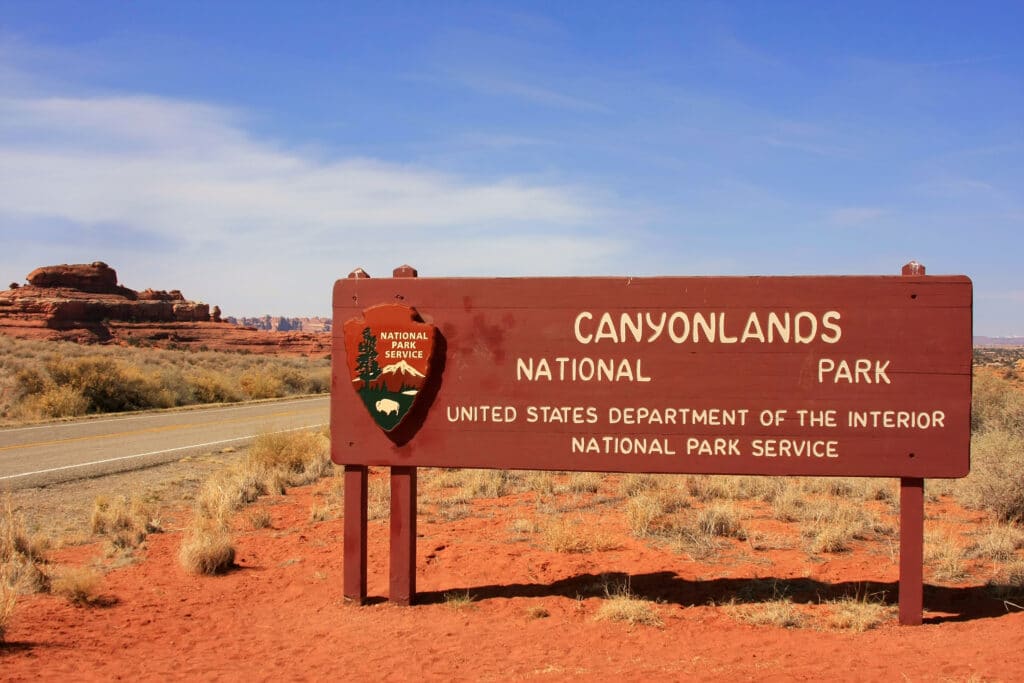
Canyonlands National Park currently charges a standard entrance fee valid for seven days: $30 per private vehicle (covering all passengers), $25 per motorcycle, or $15 per individual on foot or bicycle (with children 15 and under free). If you plan to visit multiple parks, the Southeast Utah Parks Annual Pass is available for $55 and covers Canyonlands, Arches, and nearby national monuments for one year. The national America the Beautiful pass ($80) is also accepted here, and free or discounted versions of that pass are offered to U.S. seniors, military members, veterans, and other special groups.
The park itself is open 24 hours a day, year-round with no reservation needed for entry. However, the visitor centers in the Island in the Sky and The Needles districts have seasonal schedules – generally open daily in spring through fall (around 8:00 or 9:00 am to late afternoon) but with reduced hours in winter (and a full closure of the Needles center from roughly December through early February). Some facilities like campgrounds or remote roads may close temporarily after heavy snowfall or during wildfires, but otherwise the park operates on the same schedule all year. We visited on 10 July 2025, and all figures were valid then.
Discovering the Park: What You Need to Know
Ever wondered how Canyonlands got its name? One glance at the endless maze of red-rock canyons, sheer cliffs, and solitary mesas, and you’ll understand it instantly. This national park protects a vast high-desert wilderness carved by the Green and Colorado Rivers in southeastern Utah. Established in 1964 under President Lyndon B. Johnson, Canyonlands is Utah’s largest national park (sprawling across 337.598 acres).
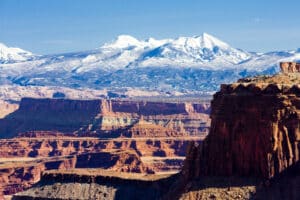
Canyonlands National Park, Utah, USA
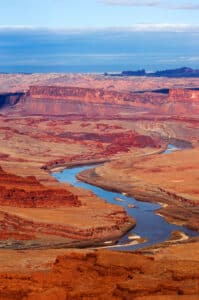
Colorado river – Canyonlands National park, Utah
The two mighty rivers intersect at the heart of the park (the Confluence) and divide it into three major districts: Island in the Sky (a lofty mesa with dramatic overlooks), The Needles (a jumble of colorful sandstone spires), and The Maze (an extremely remote labyrinth of canyons). There are no bridges or roads crossing the rivers within the park, so traveling between these districts requires driving long distances around canyons – we’re talking a 2 to 6 hour drive between visitor areas. As a result, we focused on one district at a time during our visit. Each area offers a different experience, but all showcase the park’s rugged geology and raw beauty that inspired its protection. (Interestingly, one detached section of the park, Horseshoe Canyon, was included to preserve a famous rock art panel called the Great Gallery – evidence of people living here thousands of years ago.)
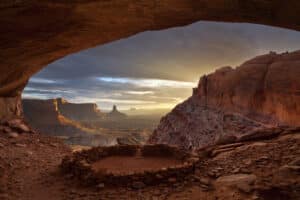
False Kiva in Canyonlands National Park, Utah
Despite it’s harsh environment, Canyonlands harbors a surprisingly rich ecosystem of plants and animals. We learned that desert bighorn sheep roam the cliffs and canyons (though they’re hard to spot against the rocks), alongside mule deer, coyotes, foxes, and countless lizards and snakes adapted to the arid landscape. Golden eagles and peregrine falcons sometimes wheel overhead, while at ground level you’ll see black-tailed jackrabbits darting between sagebrush and hear the chatter of scrub jays in the pinyon-juniper woodlands. The plant life is hardy: gnarly pinyon pine and juniper trees cling to the mesa tops, prickly pear cacti and yucca dot the washes, and in springtime vibrant wildflowers like Indian paintbrush add splashes of color to the red earth. Much of the soil is covered by a dark, crusty blanket of cryptobiotic soil – a living crust of algae, lichens, and bacteria that holds the desert floor together. We made sure to stay on marked trails to avoid stepping on this fragile soil (and we recommend every visitor do the same to help protect it).
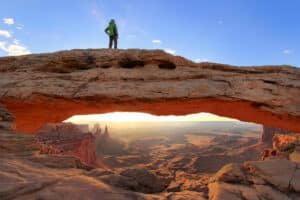
Mesa Arch, Canyonlands National Park, Utah
The climate here is one of extremes. Summer days can soar above 100 °F (38 °C) in the shade, and winter nights drop well below freezing. Spring (April–May) and fall (September–October) offer milder weather and are the most popular times to visit, whereas the colder winter months are very quiet in terms of visitors. To beat the brutal midday heat during our July trip, we started our hikes at dawn – and we recommend other summer visitors do the same and carry plenty of water. Park rangers also enforce fire restrictions in dry summer periods (for example, banning open campfires) to prevent wildfires. Overall, Canyonlands’ remoteness means services are few and you need to be self-reliant. We carried all the water, food, and fuel we needed for the day, and our preparations paid off.
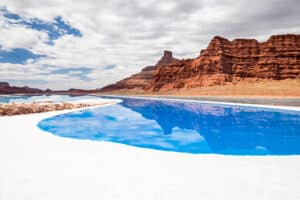
Potash pond in the Canyonlands National Park
One question we kept asking was: how much time should you plan for Canyonlands? The answer really depends on your interests, but we recommend spending at least one full day in each of the two main districts (Island in the Sky and The Needles) to get a satisfying overview. We easily filled two days with hikes and drives and still left many corners unexplored.
Island in the Sky is the most accessible district and great for a first-timer – it has a paved scenic drive with many overlooks and short trails. For instance, we hiked the short 0.5-mile (0.8 km) Mesa Arch trail at sunrise, where the sun dramatically lit up the underside of the arch and the canyon below in golden light. We also strolled along the Grand View Point trail, a 2-mile (3.2 km) round trip at the edge of the mesa, which gave us unbeatable panoramas of the canyons sprawling below. In the afternoon, we drove to Upheaval Dome and took a short but steep trail to its viewpoint – gazing down into that odd crater-like formation, we were intrigued by the park signs explaining theories of a meteor impact versus a salt dome uplift. Over in The Needles district, the experience was more remote and rugged. We tackled an all-day trek on the Chesler Park Loop, an 11-mile (18 km) hike weaving through narrow canyons and around those towering red-and-white banded pinnacles. It was a challenging hike (we went through a lot of water and got a bit sunburnt), but the surreal landscape of Chesler Park’s rock formations was absolutely worth the effort. Needless to say, we came prepared with good hiking boots and a paper map – cell service is almost non-existent out there. As for The Maze, we didn’t attempt it on this trip; that district is so remote it’s usually only visited by experienced adventurers on multi-day 4×4 expeditions or river trips. In general, Canyonlands rewarded us with solitude and grand vistas at every turn. At times we would sit quietly on a cliff edge, not another soul in sight, just taking in the silence and the humbling scale of the landscape.
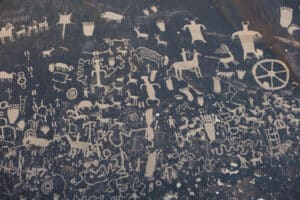
Petroglyphs on newspaper rock in Canyonlands national park, Utah, USA
Local Highlights: Trails & Food
During our stay, we discovered many other spots in and around the park that enhanced our Canyonlands experience:
-
Grand View Point Overlook – This clifftop viewpoint at the end of Island in the Sky’s road offered a breathtaking 270° panorama. We could see for dozens of miles across a tapestry of canyons and buttes, with the confluence of the Green and Colorado Rivers visible as a distant ribbon far below.
-
Mesa Arch – A short 0.5 mi/0.8 km hike led us to this famous arch perched right on the cliff’s edge. At sunrise we watched the rising sun light up the underside of the arch in a brilliant orange glow – a classic Canyonlands moment we were thrilled to witness.
-
Upheaval Dome – We hiked a steep 0.8 mi (1.3 km) trail to peer into this mysterious crater. The viewing area gave a great look at the oddly colored, concentric rings of rock, and interpretive signs discuss whether a meteor impact or an ancient salt uplift created it (scientists still debate the cause).
-
Needles District Highlights – We devoted another day to The Needles area, which felt like a different world. A short Slickrock Trail loop (around 2.4 miles) rewarded us with four distinct viewpoints overlooking the maze of spires and canyons. Along the scenic drive, we stopped at viewpoints such as Wooden Shoe Arch – a rock formation that uncannily resembles a gigantic shoe – and every stop had a unique perspective of the wild Needles landscape.
-
Dead Horse Point State Park – Just outside Canyonlands (on the same road to Island in the Sky) lies this Utah state park, which offers an absolutely jaw-dropping overlook of the Colorado River. We popped over here one evening for sunset and gazed down 2,000 feet at the river’s big gooseneck bend. The panoramic view at Dead Horse Point is so stunning that it rivals any overlook inside Canyonlands – it was well worth the short side trip for us.
-
Newspaper Rock – On the way to The Needles, we pulled off at Newspaper Rock along Utah Route 211. This large rock panel is covered in hundreds of ancient petroglyphs. We spent a few minutes deciphering the various human and animal figures carved by Indigenous peoples ages ago. It’s a fascinating and easy stop that added a historical dimension to our journey (and gave us a nice rest break during the drive).
Beyond sightseeing, Canyonlands also offered us some adrenaline-filled adventures. We’re not gonna lie – the backcountry roads here are serious business. The park has several unpaved 4×4 trails that penetrate deep into its interior, like the famous White Rim Road, a roughly 100-mile (160 km) loop that circles below the Island in the Sky mesa. We only drove a short section of it in a rented Jeep, but even that gave us a taste of true wilderness: we bumped over bedrock and sand, climbed up steep switchbacks, and felt completely dwarfed by the towering canyon walls around us. It was both thrilling and nerve-wracking (definitely not your average Sunday drive!). If you’re not experienced with off-roading, you can join a guided Jeep tour from Moab – experienced guides can take you to places like Elephant Hill (a famously challenging 4×4 route in The Needles) or even out toward The Maze safely. Meanwhile, the rivers present another epic way to experience the park. We decided to raft Cataract Canyon on the Colorado River – a multi-day guided rafting trip that travels through the heart of Canyonlands.
Over two days on the water, we floated between towering red canyon walls, camped on sandy beaches under the stars, and tackled the notorious Cataract Canyon rapids (which were absolutely roaring in early summer). It was an incredible feeling to ride those rapids knowing we were deep in a canyon that few people see from below. At night, the sky was unbelievable – thanks to Canyonlands’ designation as an International Dark Sky Park, we could clearly see the Milky Way arching over our camp. That rafting journey was definitely a highlight of our visit and gave us a perspective on the canyon landscape that you just can’t get from the overlooks.
All that exploring worked up our appetite. In the evenings, we returned to civilization (begrudgingly) to refuel. For the Island in the Sky side, we based ourselves in Moab, a lively adventure town about 30 minutes from the park entrance. Moab has plenty of dining choices and we enjoyed dinner at the Moab Brewery one evening, digging into a buffalo burger and trying their house-made beers. Another morning before heading into the park, we grabbed breakfast at the Red Rock Bakery & Cafe, enjoying fresh coffee and bagels to fuel us for the trails. When we explored The Needles district, we stayed in the small town of Monticello (about an hour south of the Needles entrance). Monticello is quieter and has fewer restaurants, but we did find a gem: Doug’s Steak & BBQ, a casual spot where we feasted on smoked brisket and cornbread that really hit the spot after a long hike. We also stopped by the local High Desert Cafe for an espresso and a homemade muffin, chatting with the friendly owner about the summer tourist season. It was a nice way to experience a bit of local community after days out in the wilderness.
Moab is also the place to pick up any supplies or souvenirs you might need. Each morning we stocked up on ice and snacks at a grocery store in town (since there’s no services inside the park beyond water and toilets). In the evenings, we browsed Moab’s outdoor gear shops and souvenir stores. There’s a strong outdoor vibe in town – we even found a small shop selling Native American handcrafted jewelry and locally made pottery, which made for unique mementos. After our final day in Canyonlands, we sat on a Moab cafe patio with cold drinks in hand, feeling that satisfying tiredness that comes from a day of adventure. We left Canyonlands dusty, a bit tired, and very happy — already dreaming about the next time we’d return.
Sorry, there were no items that matched your criteria.

